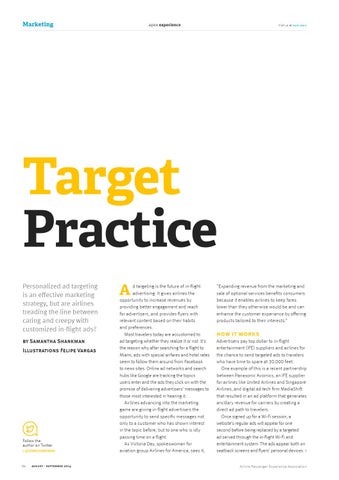Marketing
apex experience
Visit us at apex.aero
Target Practice Personalized ad targeting is an effective marketing strategy, but are airlines treading the line between caring and creepy with customized in-flight ads? by Samantha Shankman Illustrations Felipe Vargas
Follow the author on Twitter > @SAMSHANKMAN
84
august - september 2014
A
d targeting is the future of in-flight advertising: It gives airlines the opportunity to increase revenues by providing better engagement and reach for advertisers, and provides flyers with relevant content based on their habits and preferences. Most travelers today are accustomed to ad targeting whether they realize it or not. It’s the reason why after searching for a flight to Miami, ads with special airfares and hotel rates seem to follow them around from Facebook to news sites. Online ad networks and search hubs like Google are tracking the topics users enter and the ads they click on with the promise of delivering advertisers’ messages to those most interested in hearing it. Airlines advancing into the marketing game are giving in-flight advertisers the opportunity to send specific messages not only to a customer who has shown interest in the topic before, but to one who is idly passing time on a flight. As Victoria Day, spokeswoman for aviation group Airlines for America, sees it,
“Expanding revenue from the marketing and sale of optional services benefits consumers because it enables airlines to keep fares lower than they otherwise would be and can enhance the customer experience by offering products tailored to their interests.”
how it works Advertisers pay top dollar to in-flight entertainment (IFE) suppliers and airlines for the chance to send targeted ads to travelers who have time to spare at 30,000 feet. One example of this is a recent partnership between Panasonic Avionics, an IFE supplier for airlines like United Airlines and Singapore Airlines, and digital ad tech firm MediaShift that resulted in an ad platform that generates ancillary revenue for carriers by creating a direct ad path to travelers. Once signed up for a Wi-Fi session, a website’s regular ads will appear for one second before being replaced by a targeted ad served through the in-flight Wi-Fi and entertainment system. The ads appear both on seatback screens and flyers’ personal devices. > Airline Passenger Experience Association
